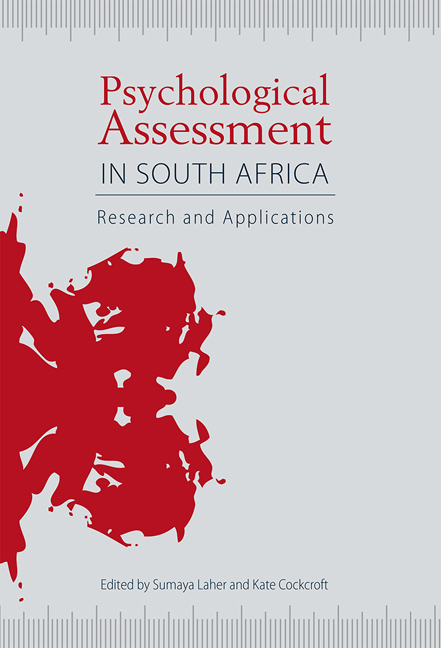Book contents
- Frontmatter
- Contents
- Tables and figures
- Acknowledgements
- Acronyms and abbreviations
- 1 Contextualising psychological assessment in South Africa
- Section One Cognitive tests: conceptual and practical applications
- Section Two Personality and projective tests: conceptual and practical applications
- 14 The Sixteen Personality Factor Questionnaire in South Africa
- 15 Using the Fifteen Factor Questionnaire Plus in South Africa
- 16 The Basic Traits Inventory
- 17 The Myers-Briggs Type Indicator® in South Africa
- 18 The NEO-PI-R in South Africa
- 19 Using the Occupational Personality Profile in South Africa
- 20 The Occupational Personality Questionnaire
- 21 The Millon Inventories in South Africa
- 22 Assessment and monitoring of symptoms in the treatment of psychological problems
- 23 Assessment in routine clinical and counselling settings
- 24 Projective assessment of adults and children in South Africa
- 25 The use of the Children's Apperception Test and Thematic Apperception Test in South Africa
- 26 Projective assessment using the Draw-A-Person Test and Kinetic Family Drawing in South Africa
- 27 The Rorschach in South Africa
- Section Three Assessment approaches and methodologies
- Contributors
- Index
17 - The Myers-Briggs Type Indicator® in South Africa
from Section Two - Personality and projective tests: conceptual and practical applications
Published online by Cambridge University Press: 21 April 2018
- Frontmatter
- Contents
- Tables and figures
- Acknowledgements
- Acronyms and abbreviations
- 1 Contextualising psychological assessment in South Africa
- Section One Cognitive tests: conceptual and practical applications
- Section Two Personality and projective tests: conceptual and practical applications
- 14 The Sixteen Personality Factor Questionnaire in South Africa
- 15 Using the Fifteen Factor Questionnaire Plus in South Africa
- 16 The Basic Traits Inventory
- 17 The Myers-Briggs Type Indicator® in South Africa
- 18 The NEO-PI-R in South Africa
- 19 Using the Occupational Personality Profile in South Africa
- 20 The Occupational Personality Questionnaire
- 21 The Millon Inventories in South Africa
- 22 Assessment and monitoring of symptoms in the treatment of psychological problems
- 23 Assessment in routine clinical and counselling settings
- 24 Projective assessment of adults and children in South Africa
- 25 The use of the Children's Apperception Test and Thematic Apperception Test in South Africa
- 26 Projective assessment using the Draw-A-Person Test and Kinetic Family Drawing in South Africa
- 27 The Rorschach in South Africa
- Section Three Assessment approaches and methodologies
- Contributors
- Index
Summary
The story of the development of the Myers-Briggs Type Indicator® (MBTI®) instrument, as captured by Wright Saunders (1991), states that in 1929 Katharine Briggs read a review of Jung's Psychological Types (Jung, 1923/1971), which at that stage had just been translated into English. She became a Jung enthusiast and spent the next 20 years studying his work and checking his theories against her own observations. She always had a strong and intuitive interest in children. It was this interest in the development and individuality of children, as well as in aspects of effective parenting, that led to her discovery and appreciation of Jung. She became convinced that what Jung had to say was of value to all people in understanding themselves and others.
Katharine shared her convictions with her daughter, Isabel Briggs Myers, and during World War II (1939–1945) the two women started developing an indicator that would enable people to gain access to their preferred Jungian type. They felt that if people could be placed in jobs which they would find satisfying, and in which they could rely on their gifts, it would not only give them greater work satisfaction but would also contribute to their increased productivity. Neither of these women were psychologists, nor had they even taken a course in psychology, but their own research had convinced them that Jung's theory was sound and practical (Wright Saunders, 1991).
Isabel formulated indicator items, and tried them out on friends and family. This was the beginning of a thorough and lengthy search for appropriate items that would more accurately enable the identification of a true type and the compilation of the Type Indicator (Wright Saunders, 1991). Over the years Isabel worked with large samples in order to validate the Indicator's use, including 15 000 nurses and 5 000 doctors. According to Van der Hoop (1970, cited in De Beer, 1997), a particular contribution that Briggs and Myers made to Jung's theory was the development of the Judging-Perceiving scale. Although Jung had mentioned that he observed differences between individuals relating to this preferred attitude to life, the Myers-Briggs team had to formulate and develop a scale to measure this attitude.
- Type
- Chapter
- Information
- Psychological Assessment in South AfricaResearch and Applications, pp. 244 - 256Publisher: Wits University PressPrint publication year: 2013



